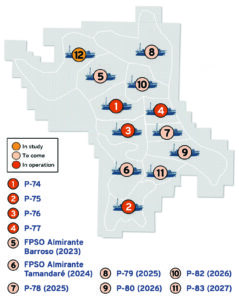Fast innovation process allows Petrobras to tap Búzios with lower cost, higher reliability
Alignment of well design with technology R&D and procurement strategy among innovations helping to maximize the presalt field’s potential


FPSOs. Four of those are already producing, and a fifth unit is expected to start producing in mid-2023. Six more units are scheduled to be delivered by 2027, and Petrobras is now considering a potential 12th FPSO.
By Linda Hsieh, Editor & Publisher
In the Búzios presalt field offshore Brazil, the numbers are staggering. The thickness of its oil reservoir, for example, can reach up to 480 m, comparable to the majestic Sugarloaf Mountain in Rio de Janeiro. Just one single well on Búzios can reach a production peak of 60,000 bbl/day, and two FPSOs on the field were able to reach their maximum capacities with just three wells. Further, by 2026, the field is anticipated to account for 33% of Petrobras’ total oil production.
“Búzios is probably the largest deepwater field in the world, or at least the largest deepwater project in the world at the moment,” Marcos Coradini Tolfo, Well Construction General Manager for the Búzios Field, said at the 2022 IADC International Deepwater Drilling & Human Performance Conference, held in Rio on 7-8 December. He expects Búzios to eventually produce 2 million bbl/day.
To tap the full potential of a giant field like this, Petrobras knew it had to innovate, both in terms of the way it approached technology and in its well construction processes.
In the first phase of the Búzios’ development after the field’s discovery in 2010, Petrobras had been contractually bound to produce only a limited volume. Embarking on the second phase of development – after securing a new contract in 2019 with the Brazilian government to access the rest of the reservoir – Petrobras developed a methodology called Selepoço. It’s a concept connecting well design with technology opportunities in the early stages of the project, Mr Tolfo said.
“Usually we would define the design of the well and the technologies that we are going to apply in phase two of the project,” he explained. “But if we wait until phase two, some of the technologies wouldn’t be applicable anymore because of the lead time to apply those technologies.”
Recognizing that being able to leverage new technologies would be key to achieving two primary goals – reduced cost and increased reliability – the operator zeroed in on minimizing the lead time to deploy new technologies. This led to the creation of the Well Efficiency Program, or PEP70, where the ambition was to achieve an average well construction duration of 70 days. It defined several focus areas for Búzios, including connecting technology development with the project’s procurement strategy.
The other pillars of the program were: well safety, which called for having high-capacity shear rams; top-hole drilling improvements; new completion technologies, including transitioning to electric controls; and reservoir scope optimization.
Open-hole intelligent completions
Mr Tolfo cited Petrobras’ open-hole intelligent completion technology, called PACI, as an example of the program’s success. Petrobras began looking at the technology in 2011 in the early days of presalt development, yet the first installation didn’t happen until 2019. “We had eight years from concept to first field installation, and eight years is too long,” he said, noting that Petrobras now aims to reduce that time to four years.
He added that the well where the first open-hole intelligent completion was installed took 91 days to drill and complete, and “today we already have one well that was drilled and completed in 65 days.”
Additional work is ongoing to further advance the technology. In 2024, for example, Petrobras expects to install its first all-electric open-hole intelligent completion, “which we expect will be a game-changer for us in terms of reliability and ability to manage the reservoir,” Mr Tolfo said.
In terms of innovations on the drilling rigs working on Búzios, Mr Tolfo said Petrobras is planning to trial NOV’s NOVOS drilling automation platform on one drillship, and two other rigs on the field – one drillship and one semisubmersible – will be outfitted with a new shear ram technology called K-BOS. Multiple rigs on Búzios are also already equipped for managed pressure drilling (MPD) operations. While MPD isn’t exactly new anymore, he said, Petrobras continues to work on enhancing the way MPD is deployed – for example, working through IADC to enhance well control training in MPD operations. DC




